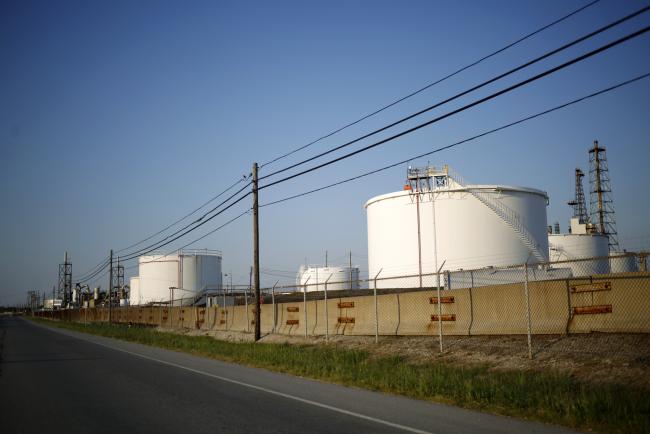 © Bloomberg. Oil storage tanks stand at the BP-Husky Toledo Refinery in Oregon, Ohio, U.S., on Monday, June 12, 2017. Global natural gas production stagnated last year as lower prices damped U.S. output for the first time since the shale boom started. Gas production was
© Bloomberg. Oil storage tanks stand at the BP-Husky Toledo Refinery in Oregon, Ohio, U.S., on Monday, June 12, 2017. Global natural gas production stagnated last year as lower prices damped U.S. output for the first time since the shale boom started. Gas production was (Bloomberg) — Oil settled at a two-year high as a drop in stockpiles added optimism to a rally underpinned by hopes for an OPEC deal extension.
Futures in New York surged 2.1 percent to close above $58 a barrel for the first time since mid-2015. Crude inventories fell by 1.86 million barrels last week, the Energy Information Administration said Wednesday. Prices briefly dipped after the report as the draw came in smaller than the 6.36 million decline posted by the American Petroleum Institute. Meanwhile, an outage on TransCanada Corp.’s Keystone pipeline has led inventories to contract in the Cushing, Oklahoma distribution hub.
“There is a fundamental under-supply right now in the global oil market, which is by definition bullish,” Pavel Molchanov, an energy research analyst at Raymond James in Houston, said by telephone. There’s a “growing recognition in the market-place that global inventories are coming down and by a substantial amount.”
The U.S. benchmark has jumped more than 6 percent this month amid signals that the Organization of Petroleum Exporting Countries and its allies may agree to prolong supply curbs beyond March when producers meet in Vienna next week.
OPEC will extend its deal through the end of 2018 when the group meets on Nov. 30, according to a Bloomberg survey of analysts and traders. The cartel is said to have invited another 20 non-members to its meeting in an effort to rebalance world oil markets, according to a person familiar with the matter.
“There is an expectation that they will extend,” Molchanov, said. “If they confirm that the cuts will be extended for a considerable length of time, let’s say nine more months, and everybody will continue to be covered who has been covered before, that may spur some additional uplift in oil.”
West Texas Intermediate for January delivery advanced $1.19 to settle at $58.02 a barrel on the New York Mercantile Exchange, the highest level since June 30. Total volume traded was about 52 percent above the 100-day average.
Keystone Outage
The front-month contract for WTI traded at a premium to all the other longer-dated futures during the session, before closing at parity with the second-month one. This market structure, known as backwardation, typically indicates strong demand and tight supplies. The last time the WTI futures curve consistently displayed this pattern was in 2014.
TransCanada plans to deliver about 15 percent of crude it hasn’t yet injected on its Keystone pipeline in November to at least one customer, according to a person familiar with the matter. The line shut last week after a leak in South Dakota. The closure has led to a tightening of crude in the U.S.
“You’re going to have a bit of a distortion with Keystone being down,” Craig Bethune, a senior portfolio manager at Manulife Asset Management, says. Yet the backwardation “indicates the market’s in relatively good health, where near-term demand is fairly strong”
for January settlement climbed 75 cents to end the session at $63.32 a barrel on the London-based ICE Futures Europe exchange. The global benchmark traded at a premium of $5.30 to WTI, the smallest since early October.
Nationwide crude stockpiles declined for the first time in three weeks to about 457.1 million barrels, according to the EIA. Crude stockpiles at Cushing, Oklahoma, the delivery point for WTI and the biggest oil-storage hub, slid by 1.83 million barrels, the biggest draw since July. Yet, U.S. output surged for a fifth week to 9.66 million barrels a day.
Oil-market news:
- Societe Generale (PA:) SA raised its 1Q 2018 WTI forecast to $54 a barrel from $49 and raised Brent to $58 from $51.50, according to an emailed note.
- Analysts, traders are bullish on WTI crude futures, according to a Bloomberg survey.
- The U.S. is unlikely to export 2 million barrels a day of crude on a sustained basis in the near-term despite reaching record levels in October, according to a paper published by The Oxford Institute for Energy Studies.
Source: Investing.com



























